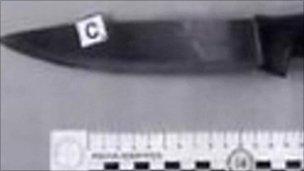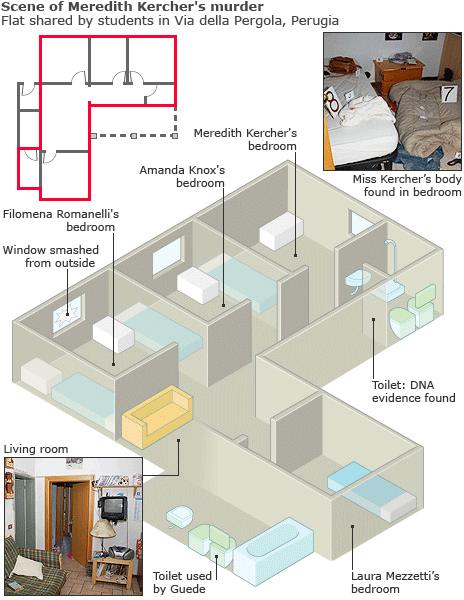Amanda Knox appeal: Reviewing the murder case evidence
- Published

The couple's "odd behaviour" after the murder did not help Knox's case
Femme fatale or unjustly-framed innocent? American Amanda Knox will soon learn whether she has won her appeal against her 2009 conviction for the murder of British student Meredith Kercher, 21.
The brutal murder of Miss Kercher, an exchange student from Coulsdon, south London, shocked the inhabitants of the Italian town of Perugia after her body was discovered in her bloodstained bedroom in November 2007.
Here, we look at the evidence against 24-year-old Knox, sentenced with her boyfriend Raffaele Sollecito to 26 and 25 years respectively - and the challenges her lawyers have been mounting against her conviction.
The knife and the bra clasp
The key evidence that helped convict Knox stemmed from police DNA tests, particularly those conducted on the murder weapon - a knife.
The forensic case also focused on the clasp of Miss Kercher's bra said to have been cut away during a struggle - but not found until six weeks after the murder.
It was this evidence that helped tip the case against Knox and her boyfriend, Raffaele Sollecito, in their first trial, external - because it was said to establish a direct physical link between the victim and her murderers.
Understandably, it is this evidence Knox's defence team have tried their hardest to discredit during the appeal, using the reports of other forensic experts to challenge the police case.
This relied on Knox's DNA, which was said to be on the handle of a knife, external found at her boyfriend's house. Police said Miss Kercher's DNA was also present on the blade.
As for the bra, it was said to hold DNA of Sollecito, which placed him at the murder scene.

Meredith Kercher's family described her as loving, kind and caring
But Italian forensic experts told the appeal court they could not be certain DNA traces found on a knife were those of 21-year-old Miss Kercher.
Because proper DNA procedures had not been followed, they said, the samples could have been contaminated, they said.
As for the bra, the defence has argued that it was found so long after the murder, that any evidence it might have contained was unreliable.
Knox's defence team and her family have repeatedly stressed no trace of Knox's DNA was ever found at the murder scene.
In return, the police have defended their handling of the forensic evidence, stressing that DNA tests were carried out behind glass screens to avoid cross-contamination.
But appeal judges refused the prosecution's request to settle the matter once and for all with fresh tests on the DNA evidence.
Knox's father Curt said: "That tells me that the court believes in the independent experts' report."
The bloody footprints
Blood-stained footprints also reportedly played a large part in the decision, external by the Italian judges to convict Knox of murder.

Police said the murder weapon had Knox's DNA on it
At the original trial a police forensic scientist testified, external that the bloody footprints of both Knox and Sollecito were found near the murder scene - although not in Miss Kercher's bedroom where the killing took place.
One of the footprints, which was found in Knox's bedroom, matched one taken from her in prison. Two other footprints - which tested positive for blood using the chemical Luminol - were found on the bath mat and in the corridor and were said to be compatible with Sollecito.
However another forensic expert testified, external the prints did not match Sollectio's feet, and instead belonged to Rudy Guede - the small-time drug dealer earlier sentenced to 16 years after being found guilty of the murder of Miss Kercher.
And Knox's defence team put up an expert of their own who challenged the police assertion, external that blood had been detected in her footprint.
The 'staged burglary'
When police discovered Miss Kercher's body in her bedroom, there were signs that a burglary had taken place - with a broken window and glass scattered around the room
However prosecutors both at the original trial, external and during the appeal have said the burglary was staged in order to distract them from the real culprits - Knox and Sollecito.
Knox's behaviour after arrest
Knox's "inappropriate" behaviour after the murder was noted by police officers and others in the murder trial.
A senior police officer told the court in Perugia, external that both Knox and Sollecito had a "strange attitude" when they were brought to the police station for questioning, following the discovery of Miss Kercher's body.
Knox was seen turning cartwheels in the police station, the court heard. On one occasion, Knox sat on Sollecito's lap while they were questioned.

Femme fatale or Jessica Rabbit? The court heard two descriptions of Amanda Knox
And TV pictures of Knox and her boyfriend embracing and kissing, external after they were questioned were seen by millions around the world.
In her defence, Knox said:, external "Everyone deals with tragedy in his own way. I'm always trying to feel less stress. I know I may appear spacey, but that's how I am."
A friend of Miss Kercher also testified, external that she found Knox's behaviour "very strange".
But in a prison interview after she was sentenced Knox said: "I know I have not always been understandable, and that I was guided for too long by stubborn naivety which created confusion."
The witnesses
The first person to be convicted of Miss Kercher's murder - Rudy Guede , external- has given different accounts of what happened on the night of the murder.
But during Knox's appeal he unequivocally named Knox and Sollecito as Miss Kercher's killers.

Raffaele Sollecito was jailed for 25 years for murdering Meredith Kercher
Knox then told the court: "The only time that Rudy Guede, Raffaele and I were in the same space has been in court. I'm shocked and anguished."
During the appeal the Knox defence team called a witness - convicted child murderer Mario Alessi - who said Guede had confessed to him in prison, saying both Knox and Sollecito were innocent of the murder.
Allessi claimed Guede told him an unnamed friend had stabbed Miss Kercher to death
Another witness who claimed to have seen Knox near the murder scene on the night Miss Kercher died was challenged as "unreliable" by the defence team.
Knox's alibi
One of the challenges facing Knox's defence team is that she too has given different accounts of where she was at the time of Miss Kercher's murder.
Shortly after her arrest, Italian police say she confessed, external to being near the scene of the crime and blocking her ears to shut out the sound of Miss Kercher's screams.
She also named a local bar-owner - Patrick Lambumba - as the murderer. He was later exonerated.
But Knox later denied being in the murder house and accused the police of beating the confession out of her, external.

Rudy Guede told the appeal that Knox helped kill Meredith Kercher
She now said she had spent the evening at Mr Sollecito's apartment, and she woke up next to him the following day.
One problem with this defence is that police have challenged Sollecito's own account of his whereabouts on the night of the murder.
Sollecito said he was working on his computer at home while Miss Kercher was being murdered.
But police say tests on his PC do not back up his account., external.
The media circus
Knox's defence has consistently argued that much of the press coverage surrounding the case has been consistently sensationalist - denying her a fair trial.
As if to illustrate their point, in the closing stages of the appeal the media made much of a lawyer's description of Knox as "diabolical" and a "witch of deception".
But in return, defence lawyers have compared the 24-year-old to Who Framed Roger Rabbit? cartoon character Jessica Rabbit.
Knox may have "femme fatale" looks but is not a killer, the lawyer said.
Like Jessica Rabbit, Knox is "not bad" but "just drawn that way", she maintained.
